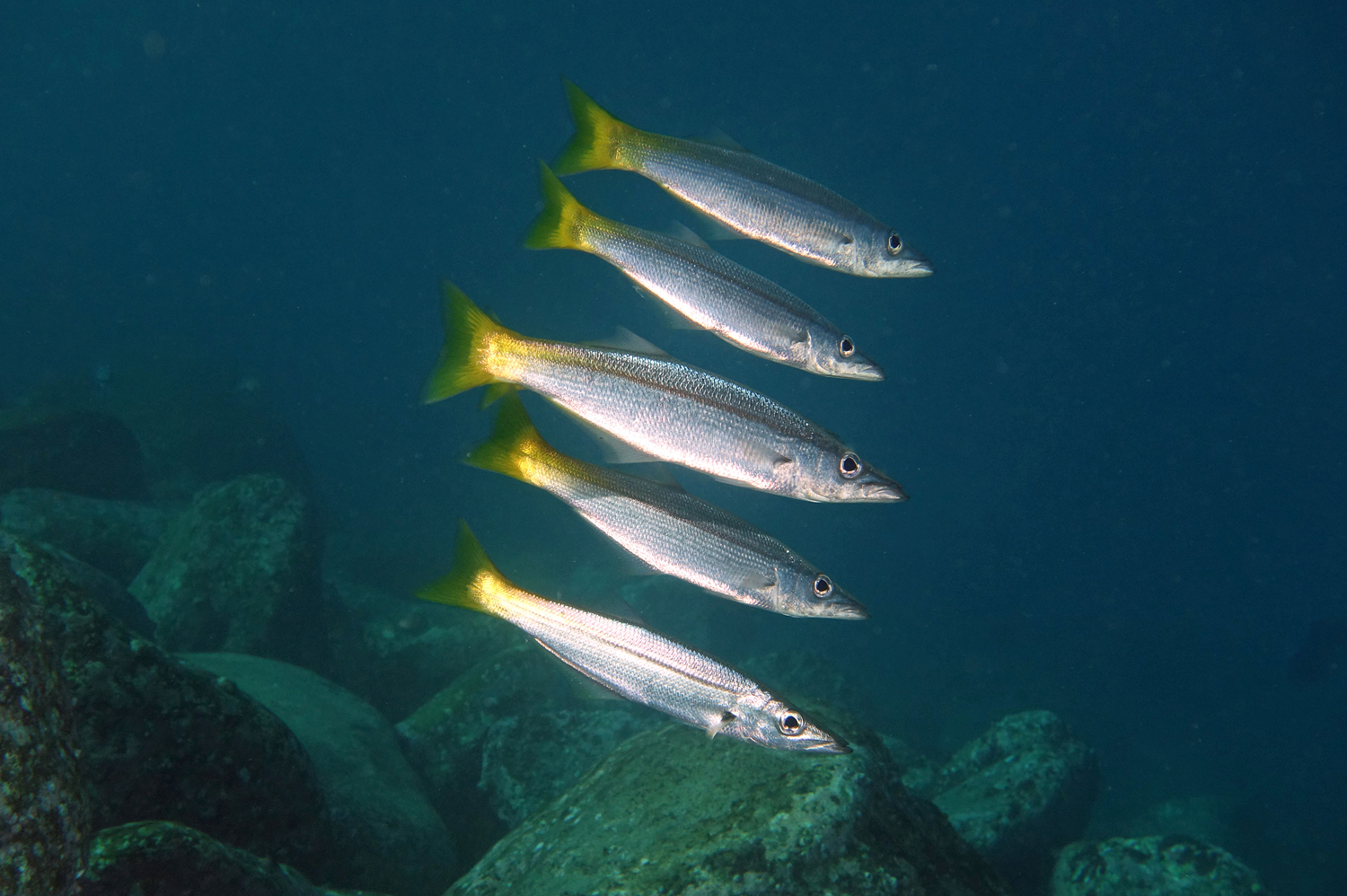Longfin Pike, Dinolestes lewini (Griffith & Smith 1834)

Long-finned Pike, Dinolestes lewini, at Shelly Beach, Manly, New South Wales, 30 May 2016. Source: John Turnbull / Flickr. License: CC by Attribution-NonCommercial-ShareAlike
Slender predatory greyish to yellowish-brown fishes becoming silvery below, with a yellow tail, a narrow pointed head, a large eye, a large mouth with a slightly protruding lower jaw, and a single row of small teeth in both jaws. The small first dorsal fin is widely-separated from the larger second dorsal, the anal fin is long-based, and the lateral line is almost straight and continues far onto the tail.
Longfin Pike are often seen hovering motionless in schools above the bottom, occasionally in their hundreds.
Video of Longfin Pike at Rye Pier, Port Phillip, Victoria.
Longfin Pike, Dinolestes lewini (Griffith & Smith 1834)
More Info
|
Distribution |
Endemic to and widespread in southern Australia from about Forster (New South Wales) around southern Australia to north of Perth (Western Australia), including around Tasmania. Inhabits coastal waters, including bays and estuaries, often near seagrass beds and exposed reefs at depths to 65 m. |
|
Features |
Dorsal fin IV-V; I, 15-19; Anal fin II, 25-29; Pectoral fin 16-17; Pelvic fin I, 5; Caudal fin 17; Gill rakers (lower limb) 15; Lateral-line scales 64-70. Body shallow (18-20% SL), cylindrical; caudal peduncle deep. Head large (approx. 30-32% SL), dorsal profile barely sloping; eyes large; mouth large, extending almost to eyes, lower jaw distinctly longer than upper jaw; teeth in upper jaw comprising single outer series of fine teeth and four large, curved, inner canines in front; teeth in lower jaw comprising single series of small teeth and two or three enlarged teeth on either side. Scales small, cycloid; lateral line mostly straight. Two widely separated dorsal fins, first short based and low, second longer based and higher, commencing above anal fin origin; anal fin similar in shape to second dorsal, but with base half again as long; caudal fin weakly forked. Pectoral fins short. Pelvic fins short, thoracic. |
|
Size |
To 90 cm, although usually to about 50 cm. |
|
Colour |
Body greyish to yellowish-brown above, silvery below tail yellow. Individuals in estuaries tend to be more yellowish or brownish than those in offshore waters. |
|
Feeding |
Carnivores - predatory fishes that feed mostly on other fishes and squids. |
|
Biology |
Early life history and larval development is described by Miskiewicz et al. (1999). |
|
Fisheries |
Not commercially fished, although reportedly good eating. |
|
Conservation |
IUCN: Not evaluated |
|
Similar Species |
Although unrelated, Longfin Pike superficially resemble barracudas of the family Sphyraenidae, which differ in having short-based dorsal and anal fins. |
|
Etymology |
The species is named after Mr Lewin who illustrated the specimen on which the original description was based. |
|
Species Citation |
Esox lewini Griffith & Smith 1834, The class Pisces, arranged by the Baron Cuvier: 465, Pl. 60. Type locality: New Holland [= Australia]. |
|
Author |
Bray, D.J. 2025 |
|
Resources |
Longfin Pike, Dinolestes lewini (Griffith & Smith 1834)
References
Allen, G.R. & M.F. Gomon. 2008. Family Dinolestidae, pp. 565-566 in Gomon, M.F., Bray, D.J. & Kuiter, R.H. (eds). Fishes of Australia's Southern Coast. Sydney : Reed New Holland 928 pp.
Castelnau, F.L. de 1872. Contribution to the ichthyology of Australia. 1. The Melbourne fish market. Proceedings of the Zoological and Acclimatisation Society of Victoria 1: 29-242 1 pl. (described as Neosphyraena multiradiata, type locality Melbourne Market, Victoria)
Coleman, N. 1980. Australian Sea Fishes South of 30ºS. Lane Cove, NSW : Doubleday Australia Pty Ltd 309 pp.
Edgar, G.J. 1997. Australian Marine Life: the plants and animals of temperate waters. Reed Books. 544 pp.
Edgar, G.J., Last, P.R. & Wells, M.W. 1982. Coastal Fishes of Tasmania and Bass Strait. Hobart : Cat & Fiddle Press 175 pp.
Fraser, T.H. 1971. The fish Dinolestes lewini with comments on its osteology and relationships. Japanese Journal of Ichthyology 18(4): 157-163. https://doi.org/10.11369/jji1950.18.157
Glover, C.J.M. 1994. Family Dinolestidae. 572 fig. 507 in Gomon, M.F., Glover, C.J.M. & Kuiter, R.H. (eds). The Fishes of Australia's South Coast. Adelaide : State Printer 992 pp. 810 figs.
Griffith, E. & Smith, C.H. 1834. The class Pisces, arranged by the Baron Cuvier, with supplementary additions, by Edward Griffith, F.R.S., &c. and Lieut.-Col. Charles Hamilton Smith, F.R., L.S.S., &c. &c. in Cuvier, G: The animal kingdom, arranged in conformity with its organization, by the Baron Cuvier, member of the Institute of France, &c. &c. &c., with supplementary additions to each order, by Edward Griffith ... and others. (2nd ed.) Whittaker & Co., London. 1-680, Pls. 1-62 + 3.
Günther, A. 1872. Description of two new fishes from Tasmania. Annals and Magazine of Natural History 4 10(26): 183-184 (described as Lanioperca mordax, type locality Tasmania)
Hoschke, A., Whisson, G. & Moore, G.I. 2019. Complete list of fishes from Rottnest Island pp. 150-161, in Whisson, G. & Hoschke, A. (eds). The Rottnest Island fish book. 2nd ed. Perth : Aqua Research and Monitoring Services.
Hutchins, J.B. & Swainston, R. 1986. Sea Fishes of Southern Australia. Complete field guide for anglers and divers. Perth : Swainston Publishing 180 pp.
Klunzinger, C.B. 1872. Zur Fische-fauna von Süd Australien. Archiv für Naturgeschichte 38(1): 17-47 pl. 2 (described as Dinolestes muelleri, type locality Hobsons Bay, Victoria)
Kuiter, R.H. 1993. Coastal Fishes of South-eastern Australia. Bathurst : Crawford House Press 437 pp.
Kuiter, R.H. 1996. Guide to Sea Fishes of Australia. New Holland. 433 pp.
Kuiter, R.H. 2000. Coastal Fishes of South-eastern Australia. Gary Allen. 437 pp.
May, J.L. & Maxwell, J.G.H. 1986. Field Guide to Trawl Fish from Temperate Waters of Australia. Hobart : CSIRO Division of Marine Research 492 pp.
Miskiewicz, A.G., Neira, F.J. & Tait, S.E. 1999. Development and ecology of larvae of the monotypic Australian fish family Dinolestidae. Australian Journal of Zoology 47(1): 37-45 https://doi.org/10.1071/ZO98068








